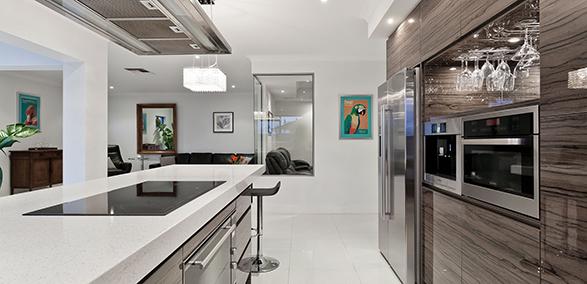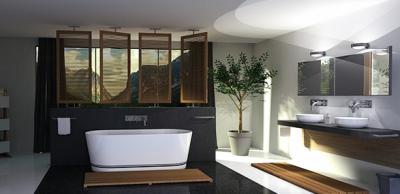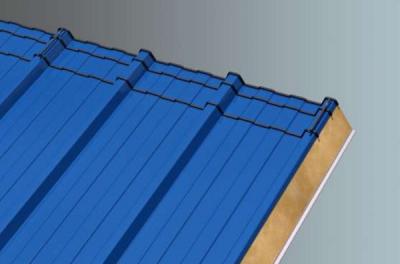When does a replacement kitchen or bathroom need building regulations approval?
The majority of domestic like for like replacement kitchens or bathrooms won't need any form of building regulations approval, but if you're modifying the existing layout then approval may be needed.
This might be due to (from the Building Regulations):
"3(b) the provision or extension of a controlled service or fitting in or in connection with a building;
3(c) the material alteration of a building, or a controlled service or fitting;
3(d) work required by regulation 6 (requirements relating to material change of use);"
A "controlled service or fitting" means;
"A service or fitting in relation to which Part G (Sanitation, hot water safety & water efficiency), H (Drainage & Waste Disposal), J (Combustion appliances & fuel storage systems), L (Conservation of fuel & power) or P (Electrical safety) of Schedule 1 imposes a requirement."
"None of the work, or any part of it, should at any stage result in not complying with or being more unsatisfactory with a relevant requirement where previously it did."
Confused?!
So what does it mean and just how is it relevant to replacement kitchens and bathrooms?
Are you undertaking the provision or extension of a controlled service or fitting? |
Does this require building regulations approval? |
| If you move the boiler to another location. | Yes (see Approved Document J in England and Wales) |
| If you leave the boiler where it is but extend the flue. | Yes (see Approved Document J in England and Wales) |
| If you install a new gas appliance. | Yes (see Approved Document J in England and Wales) |
| If you relocate the sink. | Yes, if the installation of the fitting or fittings will involve alterations to, or new connections to, a drainage stack or an underground drain, the above ground wastes and drains are controllable (see Approved Document H in England and Wales). So is the installation of hot water and wholesome water to the sink (see Approved Document G in England and Wales). |
| If you relocate the bathroom appliances. | Yes, if the installation of the fitting or fittings will involve alterations to, or new connections to, a drainage stack or an underground drain, the above ground wastes and drains are controllable (see Approved Document H in England and Wales). So is the installation of hot water and wholesome water to the bath, shower, wash basin and bidet. (see Approved Document G in England and Wales). |
| If you replace a window or external door. | Yes, this is a renovation of a thermal element (see Approved Document L1 in England and Wales). |
| If you install a new window or external door. | Yes (see Approved Document L1 in England and Wales). |
| If you install an electrical circuit. | Yes (see Approved Document P in England and Wales). |
| If you install or alter fixed electrical equipment in rooms containing a bath or a shower. | Yes, if the circuit is within the 'special location' measured 2.25m vertically from the floor or shower head (if higher) and within 600mm of any bath tub or shower tray (see Approved Document P in England). |
| If you install or alter fixed electrical equipment in the kitchen. |
In England, this is typically non-notifiable work unless a new circuit is provided e.g. installing a new built-in cooker or prefabricated modular lighting is non-notifiable unless a new circuit is required. The work still falls within the scope of Part P and should be certificated in accordance with BS7671 and local authorities can still take enforcement action if they consider the work non-compliant and unsafe. (see Approved Document P in England). In Wales, this work is typically notifiable. Notifiable jobs include new circuits back to the consumer unit, and |
| If you install an extract fan. | Yes, if it requires a new electrical circuit, the extract should go to outside where possible (see Approved Document P in England and Wales). |
Are you carrying out a material alteration?
Removing load bearing walls to accommodate a new layout is a structural alteration. Design and fire resistance will be needed for the new lintel, bearings and foundations may need to be examined for suitability.
Removing doors (or non-load bearing walls) between the kitchen and other rooms, particularly to a staircase, will affect means of escape (Requirement B1 of the Building Regulations). Additional precautions in other parts of the property may be needed such as escape windows, interlinked smoke and heat detection, and additional fire resistance (Requirement B3 of the Building Regulations). Alternatively you may need to retain the door(s) so it is no worse than before.
Are you carrying out a material change of use?
This classification involves the creation of a dwelling, subdivision to create more than one dwelling or flat or room for residential purposes. The installation of a second kitchen would indicate this likely use and building regulations approval would be required and possibly planning permission.
Could alterations alter the status of a building?
Other than change of use (above), a request may also be received to install a kitchen in a conservatory. Some conservatories are exempt from the requirement for a building regulations application. However, undertaking works to an exempt conservatory, such as removing the external doors or the opening is widened to open it up to the main house, will likely remove the exemption status enjoyed by the conservatory and approval is needed
If that happens, it reverts to an extension of the main house and thermal compliance will be difficult to achieve because of the excessive glazing. An open kitchen/dining space is a popular alteration to properties and care is needed to ensure compliance is possible.
If your building is listed in some way, for its architectural or historic interest and/or is located in a sensitive urban or rural environment (e.g. a conservation area or an area of outstanding natural beauty), then alterations may require additional consent from the planning department.
Remember the reference "Not complying with or being more unsatisfactory with a relevant requirement where previously it did"? This means that the works must not make fabric, services and fittings less compliant than they previously were – or dangerous.
For example, the provision of replacement double glazing must not worsen compliance in relation to: means of escape; air supply for combustion appliances and their flues; and ventilation for health.
Electrical installations must not worsen compliance in relation to:
- structure (depth of chases in walls, notches in floor and roof joists)
- fire safety (provision of detection systems, fire resistance of penetrations through floors and walls)
- site preparation (resistance of service penetrations to rainwater and radon)
- sound (service penetrations on party walls)
- ventilation
- thermal (use of energy efficient lighting)
- access (heights of sockets and switches)
If you're in any doubt then speak to your Principal Designer and/or Principal Contractor who can offer advice and guidance on how to comply.
Find your local authority's contact details here
Further information
Homeowners, find out much more about how the building regulations apply to your other projects such as:
Please Note: Every care was taken to ensure the information was correct at the time of publication. Any written guidance provided does not replace the user’s professional judgement. It is the responsibility of the dutyholder or person carrying out the work to ensure compliance with relevant building regulations or applicable technical standards.
This article was updated on August 2024
Sign up to the building bulletin newsletter
Over 48,000 construction professionals have already signed up for the LABC Building Bulletin.
Join them and receive useful tips, practical technical information and industry news by email once every 6 weeks.
Subscribe to the Building Bulletin




Comments
(No subject)
Submitted 7 years 3 months ago
That depends on whether the bath and shower is being moved and if new drainage is required. Changes to the electrics are also likely to be controlled, although this aspect of the work could be carried out under the Competent Persons Scheme.
Your local building control team will be able to help further with this. Enter your postcode here for their contact details https://www.labc.co.uk/our-services/find-nearest-local-council-building-control-department
Thanks,
John, LABC
(No subject)
Submitted 7 years 3 months ago
It's w70 cm l 170cm this it the WC and wall
The part with the sink and bath W200X170,so now i want to take down that wall between them and I don't know if I need approval or not,can someone advice ma pls?
Thank you
Reply
Submitted 7 years 3 months ago
Removing a non-load bearing wall between the toilet and the bath/basin wouldn't normally require a Building Regulation application.
However, if the bath, basin or W.C. are moved to new positions a Building Regulation application will be required.
If the wall being removed is load bearing or contributes to the structure of the external wall a building regulation application will be required. You'll find some information on load bearing walls here https://www.planningportal.co.uk/info/200130/common_projects/33/internal_walls/4
For specific advice on your project you can request free pre-application advice from your local building control department. (Enter your postcode details here for their contact details https://www.labc.co.uk/our-services/find-nearest-local-council-building-control-department).
Thanks,
John Allen, LABC
(No subject)
Submitted 7 years 3 months ago
E.g. up the stairs, through the kitchen, into the living room or bedroom?
Thanks
Reply
Submitted 7 years 3 months ago
That will depend on what you're doing:
If you're moving the fittings an application IS likely to be required and the drainage connections will be checked. Any alterations to the electrics will need to be undertaken by an electrical competent person.
If you're placing the kitchen in a NEW position such as a hallway a building regulation application will be required.
It's possible for a kitchen to be located in a hallway but the main issue is to check that the means of escape from the habitable rooms is still acceptable.
By the way, a building regulation application wouldn't be required to replace a kitchen or a bathroom if the sanitary fittings/sink remain in the same position.
We suggest forwarding layout plans of your proposals to your local council building control team who'll be pleased to provide free pre-application advice. You can find their contact details in our postcode finder (https://www.labc.co.uk/our-services/find-nearest-local-council-building-control-department).
I hope that helps.
John Allen, LABC
(No subject)
Submitted 7 years 3 months ago
Reply
Submitted 7 years 3 months ago
1. If a new boiler was installed when the central heating was put in, it would need to be controlled under the Building Regulations. In most cases this work is undertaken by a competent person (Gas Safe or similar) and confirmation is sent to Building Control within 30 days of completion.
2. A building regulation application would have been required for the formation of the new bathroom.
There is an option to apply to Local Authority Building Control for a regularisation certificate. Details about this are on our website, including a short video https://www.labc.co.uk/advice-building-projects/homeowners/making-a-building-regulations-application
You can find contact details of your local authority building control team here https://www.labc.co.uk/our-services/find-nearest-local-council-building-control-department
Many thanks,
John
(No subject)
Submitted 7 years 3 months ago
(No subject)
Submitted 7 years 3 months ago
Do they require a non slip surface if a shower is fitted for general use.
Do they require non slip mating if it's just a normal bath tub.
Are hand rails required as standard or just for disabled persons use.
Would greatly appreciate your advise
Thanks
Reply
Submitted 7 years 3 months ago
Thanks for your enquiry. There is no requirement under the Building Regulations to provide non-slip mats or handrails to baths.
And in relation to baths, there is a requirement - bath water can't exceed 48 degrees C to prevent scalding.
Regards,
John, LABC
Add new comment